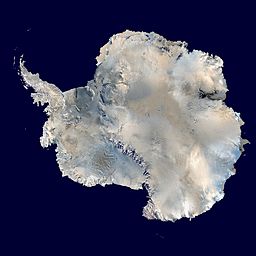By Kevin Tsai
 To many people Antarctica is nothing more than a vast expanse of snow and ice, a frozen and inhospitable continent. For scientists interested in understanding climate change and the composition of the universe, Antarctica is a promising place for making discoveries that could not be made anywhere else on Earth. An example is the Amundsen-Scott South Pole Station. The station’s telescope was built to measure the properties of light created billions of years ago during the Big Bang. From most places on earth, atmospheric water vapor blurs this light. The South Pole’s high elevation (nearly three kilometers above sea level) and extremely cold climate eliminates most water vapor, giving South Pole Telescope operators the ability to take more accurate measurements of this cosmic radiation than anywhere else on earth. Findings may allow us to better understand how the universe was formed, what it is made of, and how it is likely to change. [1]
To many people Antarctica is nothing more than a vast expanse of snow and ice, a frozen and inhospitable continent. For scientists interested in understanding climate change and the composition of the universe, Antarctica is a promising place for making discoveries that could not be made anywhere else on Earth. An example is the Amundsen-Scott South Pole Station. The station’s telescope was built to measure the properties of light created billions of years ago during the Big Bang. From most places on earth, atmospheric water vapor blurs this light. The South Pole’s high elevation (nearly three kilometers above sea level) and extremely cold climate eliminates most water vapor, giving South Pole Telescope operators the ability to take more accurate measurements of this cosmic radiation than anywhere else on earth. Findings may allow us to better understand how the universe was formed, what it is made of, and how it is likely to change. [1]
The South Pole’s extreme isolation provides scientists with a way to measure minute changes to the Earth’s atmosphere. National Oceanic and Atmospheric Administration (NOAA) scientists use weather balloons to take air samples from the Clean Air Sector of the South Pole, a desolate region where vehicle traffic is highly restricted. The nearly-emission free Clean Air Sector allows scientists to track tiny changes in levels of different gases in the atmosphere. Evaluating this data over the long-term gives us the ability to understand how those gases may affect climate change. [2]
Antarctica’s extreme geography too may give us a better understanding of the climate on on other planets as well. Scientists consider the McMurdo Dry Valleys, a series of valleys that make up one of the driest regions on Earth, as perhaps the best place to get an understanding of Mars without leaving the planet. This region of Antarctica is surprisingly barren of ice and snow; featuring extreme winds and unique microbial life. [3]
Scientists are also tracking larger life forms on the continent. Climate change has had significant effects on penguin populations in southern regions. Thinning ice in some areas has made it easier for some penguin colonies to swim to hunting grounds, while increasing snowfall in others has made it difficult for some colonies to nest. Shifts in climate may have unpredictable consequences for different penguin species, as species more adapted to icy climates, such as the Adélie penguin, may lose out to penguins better suited for warm weather, such as the Chinstrap penguin. [4]
In a project aimed at measuring climate change over the past hundred thousand years, scientists, working at the West Antarctic Ice Sheet (WAIS) Divide project, are drilling deep into the West Antarctic Ice Sheet for ice core samples. Measuring the composition of the air trapped in each layer allows scientists to develop a long-term climate history. Data from ice cores taken in Greenland will be compared to data from the WAIS Divide project to allow scientists to compare “environmental conditions between the northern and southern hemispheres… with a greater level of detail than previously possible.” [5]
Scientists are also drilling deep into Antarctic ice to research neutrinos, subatomic particles produced from high-energy particle collisions that occur during violent cosmic events, such as supernovas. These neutrinos travel extremely quickly and pass straight through matter, making them difficult to detect, much less study. On the rare occasion that a neutrino collides with an ice atom, however, a “muon” particle is emitted that appears as a flash of blue light. Scientists behind the IceCube Neutrino Detector project are drilling 1450-2450 meters into ice and extending chains of spherical optical sensors to detect these blue flashes. From there, scientists will be able to trace the path of the neutrino, and the cosmic event that created it. [6]
For the inspiration for this article and fantastic pictures of these research projects, please visit Discover Magazine at http://discovermagazine.com/photos/25-the-6-coolest-science-experiments-in-antarctica, and learn more about IEDRO’s data rescue efforts at http://www.iedro.org.
[1] http://pole.uchicago.edu/public/southpole.html
[2] http://www.esrl.noaa.gov/gmd/obop/spo/observatory.html
[3] http://www.mcmurdodryvalleys.aq/environment
[4] http://www.penguinscience.com/clim_change.php

Comments are closed.